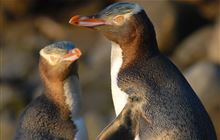Hoiho nest numbers hit rock bottom
Archived content: This media release was accurate on the date of publication.
Introduction
The yellow-eyed penguin/hoiho breeding season is looking bleak again this year, with nest numbers reaching their lowest since 1990.Date: 16 November 2015
Department of Conservation (DOC), the Yellow-eyed Penguin Trust (YEPT) and key groups involved with penguin monitoring have been counting nests for the past month. The results of this indicate nest numbers across Otago-Southland have dropped from 491 pairs in 2012 to just 160 counted so far this season. Some sites are still to be searched but numbers will probably not exceed 190 pairs.
DOC Coastal Otago Biodiversity Ranger Mel Young said "what we are seeing on the mainland is a significant reduction in breeding stocks, with negligible recruitment of young birds".
The penguin communities will work closely together over the coming months to manage and mitigate detrimental events affecting hoiho survival throughout the breeding season. As well as DOC and YEPT, other parties involved are Penguin Rescue, Penguin Place, Southland Forest and Bird, Otago University, landowners, local Rūnanga and volunteers.
Patrolling of monitoring areas will be increased throughout the season to ensure penguins are in good condition. Underweight or injured birds will be removed for treatment and rehabilitation.
Breeding adults, whose survival is essential for population stability, have been hardest hit over the last three years by several events. These included an unexplained mass mortality assumed to be from a toxic marine-based agent, widespread starvation of adults, juveniles and chicks, outbreaks of avian diphtheria in chicks, and high rates of barracouta attacks.
Mel said "the cumulative nature of multiple mass mortalities is coming home to roost. Every bird is important, and we are doing our utmost at each site".
YEPT General Manager Sue Murray said "the long-awaited good breeding season has not happened and these repeated poor breeding seasons have major management implications. The Trust, over the coming months, will be part of the collaborative effort with staff and volunteers regularly checking beaches for sign of any distressed birds and monitoring nest sites".
YEPT were pleased to report that further south on Codfish Island/Whenua Hou, nest numbers were one up on last year with 33 nests found. Sue said "finding a chick marked from the 2011/12 season is the first evidence of recruitment since the 2007/08 season, but it is insufficient to keep up with normal mortality rates. No juveniles have been seen, so none of last year's chicks are likely to enter the future breeding population". Codfish Island is a predator-free island, but the Trust has observed significant declines in this region. Numbers have decreased from 61 breeding pairs in 2001 to the 32 found both last and now this season.
Background information
A mass mortality event, assumed to be caused by an unidentified toxic agent, killed more than 70 adults and juveniles on Otago Peninsula in early 2013.
In December 2013, many chicks starved early in the season. Those that survived to fledge-age were emaciated and unlikely to survive at sea. Many adults and juveniles were in poor condition by early 2014 and unable to moult without intervention. The number of penguins needing rehabilitation increased to 329 across three Otago rehabilitation centres, straining resources and requiring tonnes of fish supplies.
More than 55 adult penguins were maimed in suspected barracouta attacks from January to April this year.
Avian diphtheria has also affected numbers as the disease has infected 90% of hoiho chicks on the Otago coast in alternate years. The disease causes ulceration of penguin chicks' mouths, making it difficult for them to eat and breathe, and can become fatal if left untreated. DOC and its partners will be providing supportive therapies including treatment of avian diphtheria and supplementary feeding for infected chicks.
In addition, interference from humans and livestock at breeding areas, heat stress, predation by stoats and ferrets, and dog attacks have reduced the number of chicks surviving to fledge age.
Before the appearance of avian diphtheria, only 19% of hoiho chicks that fledged survived their juvenile year. In the last few years, only a small number of juvenile and 2-year old penguins have been seen.
Contact
Annie Wallace
Operations Manager, DOC Coastal Otago
Phone: +64 3 474 6930
Mobile: +64 27 4 995 180
Email: awallace@doc.govt.nz
Sue Murray
General Manager, Yellow-eyed Penguin Trust
Phone: +64 3 479 0011
Mobile: +64 21 488 285
Email: sue@yeptrust.org.nz

